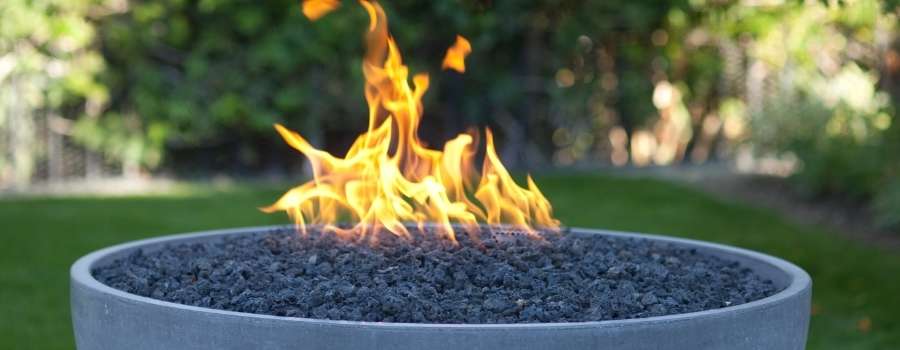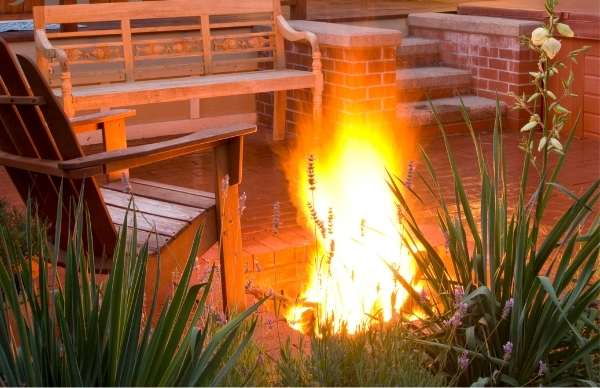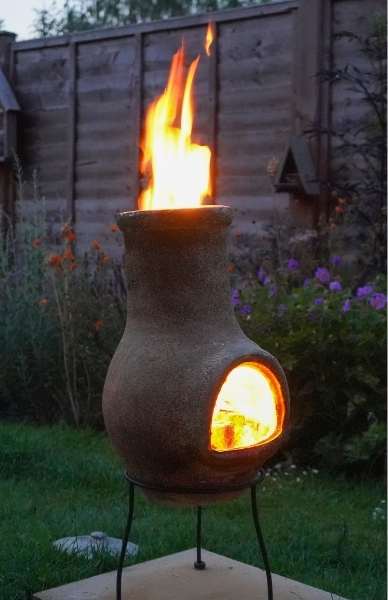
When you’re looking for a way to enjoy the outdoors, nothing beats sitting around a fire. However, when you live in an apartment or condo, it can be difficult to find an outdoor site on the property that is safe and legal to have a fire.
Luckily there are portable fire pits available! I grew up in Alaska, a place where hanging out by a fire pit was almost a nightly ritual and now that I live in North Texas I’ve been wanting to start that evening ritual down here so I’ve been researching some portable fire pits.
I decided to put this article together and share what I’ve learned…what they are, safety concerns and tips, how much they cost, and more!
What Is A Portable Fire Pit?
Typically, a portable fire pit consists of a metal ring, mesh base, and usually has feet to elevate them off the ground, which you can put wood inside and light on fire. They are usually similar to standard, metal fire pits, but are smaller and lighter in size.
Portable fire pits are going to be almost identical to any metal fire pit you’ve seen at campsites or in a friends backyard, but they are going to be much more maneuverable so that you can pack them away when you don’t need them or take them with you on your next camping trip.
They come in many different styles, shapes, sizes, and colors but the basic premise of how they work remains relatively unchanged; there’s an outer circle that allows air to enter from all angles allowing for a nice oxygen flow that helps feed the flames.
There’s usually a mesh screen or grate on the bottom to help with airflow and some even have an extra-large mesh screen around them so that you can cook over your fire pit.
A lot of times, a fire pit won’t be deemed a “portable fire pit” but it is usually listed as a feature on smaller units.
Are There Gas Burning Portable Fire Pits?
There are several fire pit manufacturers that provide a portable, propane-fueled model. These operate similarly to propane camping stoves, resulting in them being more appealing to some consumers for cooking since propane eliminates the smokey flavor and makes it easier to maintain and regulate the temperature.
| Pros | Cons |
| Indoor and Outdoor Use | Purchasing Fuel |
| No Ash or Smoke | Electric Start |
| Easy to Use | Pricier |
Indoor and Outdoor Use
One big upside to a propane model is that it can be used indoors or outdoors. This type of fire pit is considered to be much safer than an open-flame unit because the fuel source operates at lower temperatures and doesn’t emit any sparks which can cause fires. However, always exercise caution when operating these types of units.
No Ash or Smoke
Since you’re not burning wood, they also produce zero ashes or smoke, making them a much more efficient model overall. Best of all, you won’t have to worry about smoke following you around and getting in your eyes while relaxing.
Easy To Use
If you’ve never used one, they are pretty easy to set up-you simply turn the knob on top of the tank which allows gas into the burner, light it with an electric lighter (which is included) and adjust them as needed for cooking purposes.
Purchasing Fuel
The downside with propane models is that you need a fuel source in order to operate them. This can be anything from a large propane tank, disposable tanks, or even natural gas if it’s available where you live.
Electric Start
They also require electricity in order for the burner to ignite and may not function well in cold climates since the fluid will convert into a liquid which could clog the burner.
Pricier
These are also more expensive to replace when compared with wood-burning models since they have much smaller fuel sources and require electricity in order for the flame to ignite, which does add additional cost to own long term.
Can You Put A Portable Fire Pit On A Deck?
When using a fire pit, make sure it isn’t situated directly on top of your deck or patio. The extreme heat, ash, and sparks might harm the wood or discolor the cement. This also puts an open flame in close proximity to your house, raising the risk of a rogue spark or ember igniting your home.
If you’re like me then you want to keep fire pits…no matter the size…as far away from your home as possible.
But, maybe you’re a little more adventurous or have a much larger patio…I mean, some are designed with a fire pit already there. If this is the case then you still want to avoid putting the fire pit directly onto the wood or cement.
Most fire pits should have feet to help elevate it off the ground (this helps with air circulation) but you’ll also want to put it on top of a fireproof surface like stone or better yet, thanks for portability and ease of setup, a fireproof mat.
If you find that you end up with a lot of wood ash, you might be able to put it to use. Here is an article I wrote talking about 19 ways you can make that firepit ash work for you!

What Are Some Of The Benefits Of Portable Fire Pits?
- They’re very functional (providing heat, light, etc.) in addition to being decorative.
- Portable units are fairly inexpensive when compared with their larger counterparts.
- They’re easy to transport from place to place…making it a great option for camping trips, tailgating parties, and the like.
- A fire pit can come in handy during power outages by providing a warm, well lit place that your family can congregate at.
- Portable units are easy to use.
- Portable units work well if you have a small backyard or patio space…meaning your unit isn’t always in the way since it can be set up and taken down as needed.
What Are The Disadvantages Of Using Portable Fire Pits?
- Some portable fire pits may not come with all of the parts, accessories, and/or instructions needed to use the unit.
- In some cases, a portable fire pit may be too small for your needs…meaning you’ll have to settle on something smaller than what you had in mind.
- While less expensive than larger fire pits, some find that the price to size/feature ration might not be worth it.
- In addition, give your portable fire pit AMPLE time to cool off before moving, handling, storing it (or placing the cover on).
Portable Fire Pits: Potential Safety Concerns
The big, obvious thing here is fire…you’re using a fire pit, so there’s going to be fire, smoke, sparks, and floating embers. And since we’re talking about a portable fire pit, there are a few extra things to double-check to keep you and others safe.
- If you’re cooking on them, make sure that you’re not preparing food that’s extremely greasy. You’re working in a smaller area, so people are huddled up closer to the flame…greasy food like to pop and sling grease (sometimes several feet away) all over the place.
- Never place your portable fire pit under an overhang (trees, brush, gazebo, covered porch, etc.) when you intend to use it.
- Wood burning models will put off smoke, so make sure you’re using it in an area with excellent ventilation…basically outside and away from anything flammable.
- If you intend to take it with you on camping trips, remember to take along a fire proof mat. If you don’t have one or forget it, put your fire pit on to flat stones or pavers…in short, keep it from directly touching a flammable surface.
- Always remember to properly douse your fire and the surrounding area (incase one of those pesky embers got away from you.) In addition, give your portable fire pit AMPLE time to cool off before picking it up and packing it back in to your vehicle.
- Have a way to snuff out the fire…some gravel, sand, or (preferably) an ABC fire extinguisher. Water will suffice in a pinch but if you were cooking, any grease from the meal will make using water less effective.
What Are Some Alternatives To A Portable Fire Pit?
If you’re looking for a more simplistic way to safely have a fire you can use a fire ring, and for a more decorative option you can get a chiminea, which is a hand-made decorative chimney made of terra cotta.
Some Ideas For Portable Fire Pits:
- Fire Ring
- Chiminea
- Gardening Pot
- Galvanized Bucket
Fire Ring
A fire ring is just a simple, steel ring that measures about 45 inches to 60 inches in diameter and 6 to 8 inches high…however other sizes are also common.
Many people will use these as portable units for use on camping trips, but their typical use is as a liner for a permanent stone or brick fire pit.
Chiminea

A chiminea is a hand-built decorative clay and metal tube used to create heat. They come in many different sizes, but the average size is about 36 inches tall with an 18-inch base diameter.
Chimineas are often converted into a functional grill and many people will use them in place of a wood-burning fire pit that they can cook over. Some have even added wracking so that they can be used as outdoor pizza ovens.
Garden Pot
The garden pot looks like your basic terra cotta flowerpot…but it has a hole in the bottom for drainage. This is a great option if you’re looking to have convenience and ease without sacrificing too much decor.
Terra cotta, like chiminea’s, can easily be converted for cooking…from grilling to smoking, with a little DIY know how you can have a cheap and effective outdoor kitchen all in one.
Galvanized Bucket
Yes, a bucket! By adding the right fittings (and some elbow grease) you can turn an ordinary galvanized or steel bucket into a highly portable fire pit that’s perfect for camping trips and even home use. For more information about using a galvanized bucket as a portable fire pit, check out this article.
Final Thoughts
A portable fire pit can be a great addition to your backyard, camping trips, and power outages…the perfect combination of function and decoration for anyone looking to add something unique.
When choosing the right unit it’s important that you know who will use it most often, how long they’ll spend around the fireplace, what features are most important to you, etc.
If all of that is taken into consideration then there’s no reason why your family won’t be spending time together with the portable fire pit for years to come!
